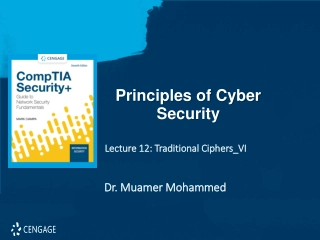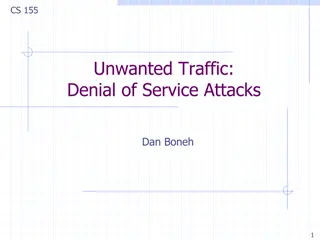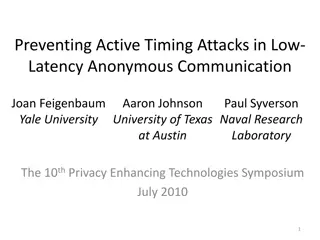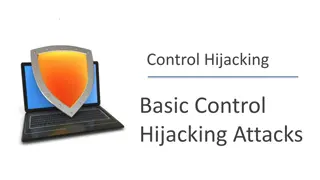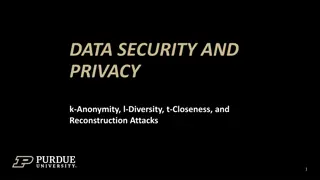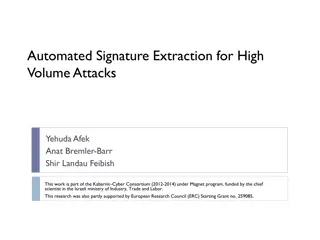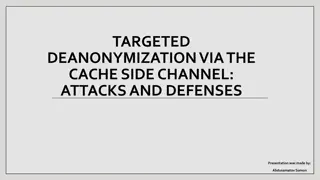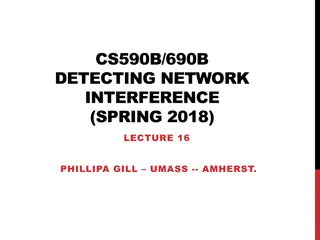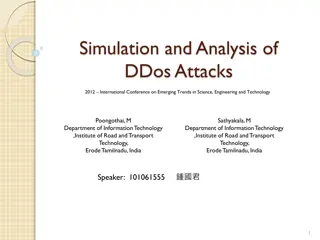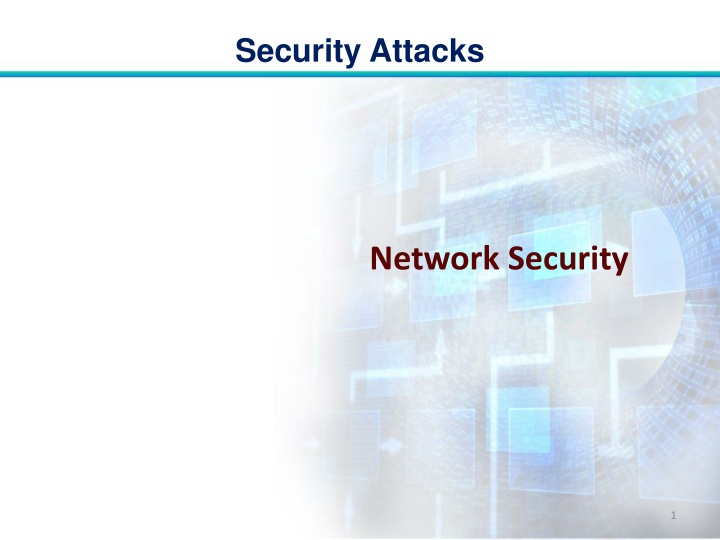
Security Attacks: Passive vs. Active Techniques
Explore the world of security attacks in network security, categorized as passive and active attacks. Learn about the objectives, figures, and classifications according to OSI Architecture X.800. Dive into the details of passive attacks, including release of message contents and traffic analysis, to protect against potential threats and breaches.
Download Presentation

Please find below an Image/Link to download the presentation.
The content on the website is provided AS IS for your information and personal use only. It may not be sold, licensed, or shared on other websites without obtaining consent from the author. If you encounter any issues during the download, it is possible that the publisher has removed the file from their server.
You are allowed to download the files provided on this website for personal or commercial use, subject to the condition that they are used lawfully. All files are the property of their respective owners.
The content on the website is provided AS IS for your information and personal use only. It may not be sold, licensed, or shared on other websites without obtaining consent from the author.
E N D
Presentation Transcript
Security Attacks Network Security 1
Security Attacks Objectives of the Topic After completing this topic, a student will be able to describe the security attacks. 2
Security Attacks Figures and material in this topic have been adapted from Network Security Essentials: Applications and Standards , 2014, by William Stallings. 3
Security Attacks According to the OSI Architecture X.800, security attacks can be classified in two categories: passive attacks, and active attacks 4
Security Attacks A passive attack attempts to learn or make use of information from the system but does not affect system resources. An active attack attempts to alter system resources or affect their operation. 5
Security Attacks Passive Attacks: Passive attacks are in the nature of eavesdropping on, or monitoring of, transmissions. The goal of the opponent is to obtain information that is being transmitted. 6
Security Attacks Passive Attack 7
Security Attacks There are two types of passive attacks release of message contents, and traffic analysis. 8
Security Attacks Release of message contents: A telephone conversation, an e- mail message, and a transferred file may contain confidential info. Prevent an opponent from learning contents of these transmissions. 9
Security Attacks Traffic Analysis: Even if contents of messages are encrypted, an opponent might still be able to observe the pattern of these messages. 10
Security Attacks He could determine the location and identity of communicating hosts and could observe the frequency and length of messages being exchanged. He can guess the nature of the communication. 11
Security Attacks Passive attacks do not alter the data. Neither the sender nor receiver is aware that a third party has observed the traffic pattern. Emphasis is on prevention rather than detection. Use Encryption. 12
Security Attacks Active Attacks: Active attacks involve some modification of the data stream or the creation of a false stream. 13
Security Attacks Active Attack 14
Security Attacks Active attacks can be subdivided into four categories: masquerade, replay, modification of messages, and denial of service. 15
Security Attacks Masquerade: It takes place when one entity pretends to be a different entity. It usually includes one of the other forms of active attack. 16
Security Attacks Replay: It involves the passive capture of a data unit and its subsequent retransmission to produce an unauthorized effect. 17
Security Attacks Modification of messages: It simply means that some portion of a legitimate message is altered, or that messages are delayed or reordered, to produce an unauthorized effect. 18
Security Attacks Denial of Service: It prevents or inhibits the normal use or management of communications facilities. E.g. an entity may suppress all messages directed to a particular destination. 19
Security Attacks Active Attacks are difficult to prevent because of the wide variety of potential physical, software, and network vulnerabilities. Goal is to detect attacks and to recover from any disruption or delays caused by them. End 20




